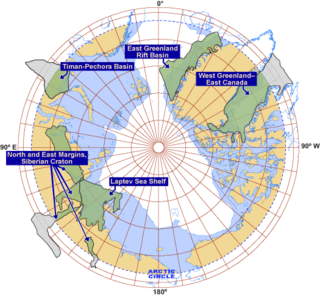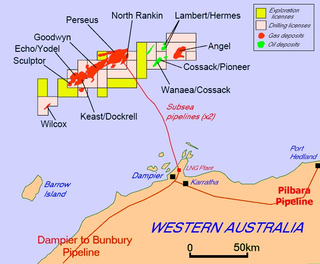
The history of the petroleum industry in the United States goes back to the early 19th century, although the indigenous peoples, like many ancient societies, have used petroleum seeps since prehistoric times; where found, these seeps signaled the growth of the industry from the earliest discoveries to the more recent.

Chevron Corporation is an American multinational energy corporation predominantly specializing in oil and gas. The second-largest direct descendant of Standard Oil, and originally known as the Standard Oil Company of California, it is active in more than 180 countries. Within oil and gas, Chevron is vertically integrated and is involved in hydrocarbon exploration, production, refining, marketing and transport, chemicals manufacturing and sales, and power generation.

ConocoPhillips Company is an American multinational corporation engaged in hydrocarbon exploration and production. It is based in the Energy Corridor district of Houston, Texas.

Santos Ltd. is an Australian oil and gas exploration and production company, with its headquarters in Adelaide, South Australia. It owns liquefied natural gas (LNG), pipeline gas, and oil assets. It is the biggest supplier of natural gas in Australia, with its plants in the Cooper Basin in South Australia and South West Queensland supplying the eastern states of Australia. Its operations also extend to the seas off Western Australia and Northern Territory.
Woodside Energy Group Ltd is an Australian petroleum exploration and production company. Woodside is the operator of oil and gas production in Australia and also Australia's largest independent dedicated oil and gas company. It is a public company listed on the Australian Securities Exchange and has its headquarters in Perth, Western Australia. In the 2020 Forbes Global 2000, Woodside was ranked as the 1328th-largest public company in the world.

Origin Energy Ltd is an ASX listed public company with headquarters in Sydney. It is a major integrated electricity generator, and electricity and natural gas retailer. It operates Eraring Power Station, Australia’s largest coal-fired power station, in New South Wales, which it plans to close in 2025. As of 2024, it plans to "minimise" its ownership of wind and solar power, to boost investor returns. It owns 20% of Octopus Energy, a UK renewable energy retailer.

Petroleum production in Canada is a major industry which is important to the overall economy of North America. Canada has the third largest oil reserves in the world and is the world's fourth largest oil producer and fourth largest oil exporter. In 2019 it produced an average of 750,000 cubic metres per day (4.7 Mbbl/d) of crude oil and equivalent. Of that amount, 64% was upgraded from unconventional oil sands, and the remainder light crude oil, heavy crude oil and natural-gas condensate. Most of the Canadian petroleum production is exported, approximately 600,000 cubic metres per day (3.8 Mbbl/d) in 2019, with 98% of the exports going to the United States. Canada is by far the largest single source of oil imports to the United States, providing 43% of US crude oil imports in 2015.

APA Corporation is the holding company for Apache Corporation, an American company engaged in hydrocarbon exploration. It is organized in Delaware and headquartered in Houston. The company is ranked 431st on the Fortune 500.

Shell Australia is the Australian subsidiary of Shell. Shell has operated in Australia since 1901, initially delivering bulk fuel into Australia, then establishing storage and distribution terminals, oil refineries, and a network of service stations. It extended its Australian activities to oil exploration, petrochemicals and coal mining, and became a leading partner in Australia's largest resource development project, the North West Shelf Venture.

Exploration for petroleum in the Arctic is expensive and challenging both technically and logistically. In the offshore, sea ice can be a major factor. There have been many discoveries of oil and gas in the several Arctic basins that have seen extensive exploration over past decades but distance from existing infrastructure has often deterred development. Development and production operations in the Arctic offshore as a result of exploration have been limited, with the exception of the Barents and Norwegian seas. In Alaska, exploration subsequent to the discovery of the Prudhoe Bay oilfield has focussed on the onshore and shallow coastal waters.

Equinor ASA is a Norwegian state-owned multinational energy company headquartered in Stavanger, Norway. It is primarily a petroleum company operating in 36 countries with additional investments in renewable energy. In the 2020 Forbes Global 2000, Equinor was ranked as the 169th-largest public company in the world. In 2023, the company was ranked 52nd in the same list. As of 2021, the company has 21,126 employees.
The Cooper Basin is a Permian-Triassic sedimentary geological basin in Australia. The intracratonic rift basin is located mainly in the southwestern part of Queensland and extends into northeastern South Australia. It is named after the Cooper Creek which is an ephemeral river that runs into Lake Eyre. For most of its extent, it is overlain by the Eromanga Basin. It covers 130,000 km2.
This page summarizes projects that brought more than 20,000 barrels per day (3,200 m3/d) of new liquid fuel capacity to market with the first production of fuel beginning in 2007. This is part of the Wikipedia summary of Oil Megaprojects.

The North West Shelf Venture, situated in the north-west of Western Australia, is Australia's largest resource development project. It involves the extraction of petroleum at offshore production platforms, onshore processing and export of liquefied natural gas, and production of natural gas for industrial, commercial and domestic use within the state. North West Shelf gas is processed at the Woodside Energy operated Karratha Gas Plant, located on the Murujuga Cultural Landscape The North West Shelf Venture is often cited as the single largest industrial emitter for Australia according to the Clean Energy Regulator.

The petroleum industry in Western Australia is the largest contributor to the country's petroleum exports. Western Australia's North West Shelf (NWS) is the primary location from which production originates. Oil exports are shipped from Port Hedland.

Roc Oil Company Limited is a petroleum company based in Sydney, Australia. It was established in 1997 as a privately owned company by John Doran. In 1999, the company was listed on the Australian Securities Exchange, and in 2004, was listed on the Alternative Investment Market in London, becoming a dual listed company. In 2008, Roc Oil merged with Anzon Australia, and in 2014 it was acquired by Fosun International.

The Australian Energy Producers (AEP), formerly known as the Australian Petroleum Production and Exploration Association (APPEA), is a peak industry body representing Australia's oil and gas exploration and production sector. Founded in 1959, AEP is headquartered in Canberra, Australia.
Senex Energy Pty Ltd (Senex) is an Australian energy company that was listed on the Australian Securities Exchange (ASX) in 1984 until 2022. The business is now privately owned by POSCO International and Hancock Prospecting. The name refers to the Latin word Senex.
Australia is a major petroleum producer and importer, with a number of petroleum companies involved in upstream and downstream operations. Western Australia is the largest contributor to Australia's production of most petroleum products.
Meg O'Neill is an American business executive and the current chief executive officer (CEO) and managing director of Woodside Energy, Australia's largest oil and gas company.













